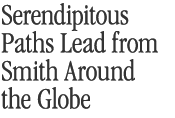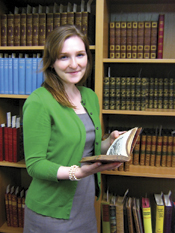
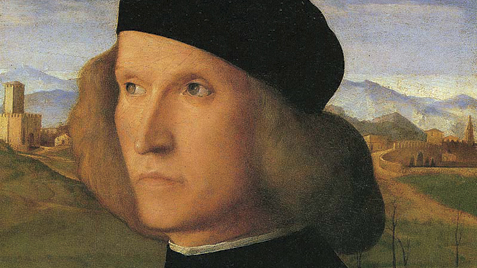
Giovanni Bellini's portrait of leading Petrarch scholar Pietro Bembo, later Cardinal Bembo, who borrowed "The Madrid Petrarch" from Bortolomeo della Valle in 1511. Image courtesy of the Royal Collection, Hampton Court.
/ NewsSmith, Fall 2008
The manuscript had been missing since 1511 when Italian scholar Pietro Bembo borrowed it for summer reading. In 1608, it appeared in the personal property of Juan Fernandez de Velasco, Duke of Frias and governor of Milan in the late 1500s. In 1736, it was placed in Madrid's Biblioteca Nacional. There it sat, unknown to bibliographical scholars until now — the "Madrid Petrarch" manuscript, a tantalizing hidden clue to the mysterious life of Ludovico degli Arrighi, Vatican copyist and Renaissance type designer, friend and collaborator of Raphael's, and master of chancery cursive script.
Recently Martin Antonetti, curator for Smith's Mortimer Rare Book Collection, found an oblique reference to the manuscript in a linguistics journal and sent his research assistant to Madrid to analyze the sumptuous codex and verify the true publisher — ultimately changing what was known about a significant piece of art history.
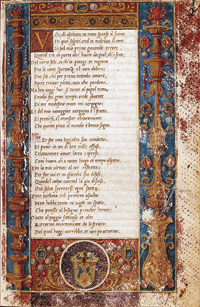
The “Madrid Petrarch” of 1508 with Arrighi’s chancery cursive script and Bartolomeo della Valle’s coat of arms in the bottom margin.
That assistant, Zoe Mindell '08, was already spending her junior year abroad in Florence when Antonetti first told her about his discovery. "We realized that someone had to examine the manuscript itself, in detail. Since I was already in Florence, Martin found the funds for a three-day trip and wrote the necessary letters of introduction to Madrid's Biblioteca Nacional. Soon I was corresponding with the manuscript librarian and boarding a plane to Spain.
"The illuminated manuscript was pristine, dated 1508. I pored over each folio, taking copious notes on content and appearance. As I admired a particular illumination, I noticed a series of golden letters interwoven in the marginal decoration: BART DE VAL. It wasn't until I reported on my findings to Martin that we realized the significance of my observation. Martin suggested that Bartolomeo della Valle, not his brother Cardinal Andrea della Valle, had commissioned the manuscript. That changed the provenance of the piece."
Ludovico degli Arrighi, also called Vicentino, was born to a poor family in a world where good positions required money and influence. A young man with a fine hand might aspire to the position of papal scriptor, a transcriber of administrative briefs and papal bulls, but it required a wealthy relative or patron to put up the 1200 ducats to purchase the position in the papal chancery. While the job would not make you wealthy, you could advance to the papal Curia's upper echelons, connected to every sphere of wealth and power.
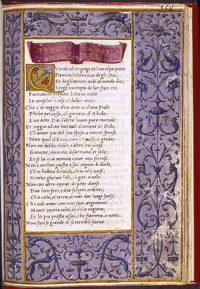
Another page of the "Madrid Petrarch" with della Valle’s initials in the tiny panels in the right and bottom margins. The illuminations are thought to be by Matteo da Milano.
In addition to work in the Curia, Arrighi did what we would call freelance work as a professional calligrapher. From 1515 to 1525, he worked with some of the finest illuminators to create magnificent presentation manuscripts for wealthy clients, many of whom were cardinals. He produced two seminal manuals on writing, followed in 1524-27 by a series of small, beautifully printed books using type based on his own elegant hand. And then he vanished, probably one of thousands of victims in the months-long reign of terror that was the Sack of Rome in 1527. Of the works he produced, only a handful have survived. Of these, only two are actually signed by Arrighi the scribe; Antonetti's discovery adds a precious third.
As he cataloged the collection of Italian Renaissance books acquired by Ruth Mortimer for the rare book collection before she died in 1994, Antonetti had many puzzling questions. How did Arrighi, an unknown youth from the provinces, obtain his position in the papal Curia? How did he enter a network that allowed him to publish for some of the most powerful people in Rome? Where did he perfect his skills? What happened to the manuscript that Cardinal Bembo borrowed — and undoubtedly returned — in the summer of 1511, before it surfaced in 1608 in the estate of Juan Fernandez de Velasco? When did Arrighi actually begin his work in Rome?
The proper attribution of the "Madrid Petrarch," hidden from scholars for so many years, places Arrighi in Rome in 1508, two years earlier than previous research had established. Other questions are being researched by Antonetti and Mindell in the archives of Rome, Vicenza, Padua and Venice. Meanwhile, the proper attribution of a folio that survived for 500 years teaches us a little more about an artist's life in one of history's most powerful and complex societies.













